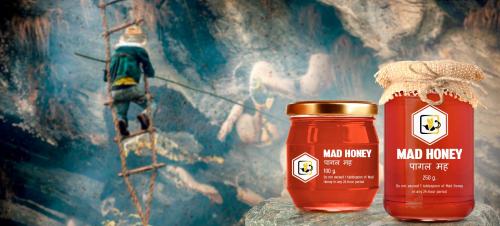Mad Honey: The Real Story

The remote, obscure high Hills of Nepal have their fair share of remarkable things. While the existence of some of the beings said to be living in the Himalayas is controversial, such as the Yeti, there are others whose existence will hit you like a brick wall should you ever come across it. Believe it or not, Nepal’s dangerous cliffs are also home to a one of a kind wild honey bee that will make you hallucinate with their psychedelic honey. This honey is reportedly found only in certain altitudes of Nepal, China, and Turkey!
The Himalayan Cliff Bee, or Apis dorsata laboriosa, is an ally to humans in the manufacturing of hallucinogens from substances found in nature. It is the largest honeybee and is found exclusively in the mountainous areas of Nepal, India, and Yunnan, reaching upto 4000 meters above sea level. Also found at similar altitudes is Nepal’s national flower, Rhododendron or the “Lali Gurans”, which provides pollen for these gigantic bees. The pollen of only three specific rhododendron species contains a compound called grayanotoxin that makes this honey “trippy”. While the compound – as the “toxin” in the name suggests – is toxic, the honey can provide a pleasant experience if taken in small amounts. However, it is famously referred to as “mad honey” due to the light-headedness and hallucinations it causes even in small quantities.
The earliest written record of the hallucinogenic property of the mad honey dates back to 120 BC in Pontus (now Turkey). Mithridates the Great, one of the most powerful enemies of Roman Empire, reportedly used these wild bees and their honey to poison the Roman troops making this the first ever chemical weapon. While 4700 km away from Nepal, the region of Turkey that has this honey has similar key ingredients: poisonous rhododendrons, high altitude and wild bees. So, even today, specific areas of Turkey are home to this sweet, potent nectar locally known as ‘deli bal’. This honey has quite a reputation for the buzz (pun intended) it provides.
As for Nepal, the mad honey is just as famous as the hunters who brave the cliffs to harvest them. The Gurung people, a tribe residing in the high Himalayas of Nepal, follow a centuries-old ritual of mad honey hunting bi-annually. While we enjoy the last of the summer vacations here in the US (unless you are a grad student of course), the bravest and strongest in the Gurung tribe ascend on a treacherous traditional journey of harvesting mad honey. The ritual is not only dangerous, but sometimes fatal. There is only minimal protective clothing and simple makeshift gear useds, making every harvest a death defying process. That is why it is light-heartedly suggested that in the context of Nepal, the term mad is used not just for the honey, but also for the madly brave hunters who go to retrieve it.
The mad honey harvesting is a team effort and this requires extensive coordination among the hunters. The bravest ones will descend down the inaccessible cliffs that house huge, crescent-shaped hives. They are sometimes covered with jute sacs (used for grains) or nets on their head, but almost certainly barefooted for easier foot hold. Others in the team engulf the hives by thick, acrid smoke created by burning piles of branches and leaves from the bottom of the cliff to drive the bees out. The main hunter, while dangling dangerously mid-air, stabs at a hive with a bamboo stick with a sickle at one end, cutting the exposed honeycomb away from the cliff face. To catch the honeycomb, this hunter uses another stick to guide a basket hanging beside him with handmade ropes. Another team member is responsible for either pulling the basket up or lowering it down in ropes to retrieve the harvested hives. This breathtaking spectacle and the locals’ devotion to this tradition can be seen in several documentaries, such as “The Last Honey Hunter” by Ben Knight, “Hallucinogen Honey Hunters” by Raphael Treza and “The Nepalese Honey That Makes People Hallucinate” by Munchies.
The earliest written record of the hallucinogenic property of the mad honey dates back to 120 BC in Pontus (now Turkey). Mithridates the Great, one of the most powerful enemies of Roman Empire, reportedly used these wild bees and their honey to poison the Roman troops making this the first ever chemical weapon. While 4700 km away from Nepal, the region of Turkey that has this honey has similar key ingredients: poisonous rhododendrons, high altitude and wild bees. So, even today, specific areas of Turkey are home to this sweet, potent nectar locally known as ‘deli bal’. This honey has quite a reputation for the buzz (pun intended) it provides.
Post Your Ad Here
Comments